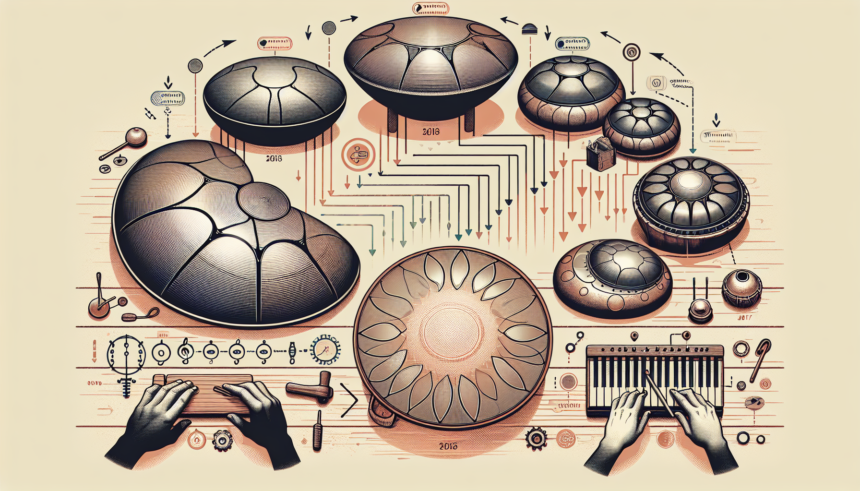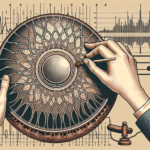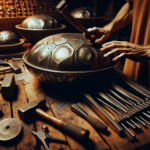<!DOCTYPE html>
<html lang="en">
<head>
<meta charset="UTF-8">
<meta name="viewport" content="width=device-width, initial-scale=1.0">
<title>The Evolution of Handpan Design</title>
<style>
body {
font-family: Arial, sans-serif;
line-height: 1.6;
margin: 0;
padding: 0;
}
.container {
width: 80%;
margin: 0 auto;
padding: 20px;
}
h1 {
text-align: center;
margin-bottom: 40px;
}
h2 {
border-bottom: 2px solid #ccc;
padding-bottom: 10px;
margin-top: 40px;
}
p {
margin: 20px 0;
}
.faq-section {
margin-top: 60px;
}
.faq {
margin-bottom: 20px;
}
.faq h3 {
margin: 0;
}
</style>
</head>
<body>
<div class="container">
<h1>The Evolution of Handpan Design: Innovations and Trends</h1>
<p>The handpan, a relatively recent musical instrument, has captivated musicians and audiences alike with its ethereal sound and unique design. Since its inception in the early 2000s, the handpan has undergone significant evolution in both its construction and the materials used. This article delves into the history, innovations, and current trends in handpan design.</p>
<h2>Origins and Early Development</h2>
<p>The handpan traces its roots to the late 20th century, with the invention of the Hang in Switzerland by Felix Rohner and Sabina Schärer of PANArt. Introduced in 2001, the Hang was crafted from two half-shells of nitrided steel, creating a convex shape. The instrument featured a central note known as the “Ding” and a series of tone fields distributed around it.</p>
<p>The Hang's arrival marked a revolution in the world of percussion instruments. Its ability to produce melodic tones, sustained sounds, and harmonic overtones distinguished it from traditional percussion instruments. The unique sound of the Hang quickly gained popularity, inspiring other craftsmen to experiment and develop similar instruments.</p>
<h2>Materials and Construction Techniques</h2>
<p>The original Hang was made using nitrided steel, which was chosen for its rust-resistant properties and the ability to hold tunings well. Over time, artisans began exploring alternative materials and construction techniques to further enhance the instrument's sound and durability.</p>
<p>1. <strong>Stainless Steel:</strong> Stainless steel emerged as a popular alternative due to its resistance to rust and corrosion. Instruments made from stainless steel also exhibited a brighter and more resonant sound.</p>
<p>2. <strong>Composite Materials:</strong> Some manufacturers experimented with composite materials, combining different metals to achieve unique tonal qualities and aesthetic appearances.</p>
<p>3. <strong>Heat Treatment:</strong> Advances in heat treatment techniques allowed for better control over the instrument's hardness and tuning stability. Nitriding processes evolved, resulting in less fragility and better tone consistency.</p>
<h2>Innovations in Tuning</h2>
<p>Tuning is a critical aspect of handpan design, and innovations in this area have played a significant role in the instrument's evolution. Various tunings, scales, and note layouts have been developed over the years to cater to different musical preferences and playing styles.</p>
<p>1. <strong>Diatonic and Chromatic Scales:</strong> While early handpans were mostly tuned in diatonic scales, modern designs have expanded to include chromatic options, providing players with a broader musical range.</p>
<p>2. <strong>Custom Tunings:</strong> Some builders offer custom tunings, allowing musicians to create instruments tailored to their specific needs.</p>
<p>3. <strong>Double Ding:</strong> This innovation features two central notes ("Ding") instead of one, offering a more complex and versatile sound palette.</p>
<h2>Design Aesthetics and Finishes</h2>
<p>As handpans gained popularity, artisans began experimenting with design aesthetics and finishes to make the instruments not only sound beautiful but also visually appealing.</p>
<p>1. <strong>Color Coatings:</strong> Handpans with various color coatings or patinas have become popular. These coatings not only provide an aesthetic appeal but also protect the instrument from environmental damage.</p>
<p>2. <strong>Engravings:</strong> Some handpans feature intricate engravings or patterns, adding an artistic element to the instrument. These designs often reflect cultural motifs or personal expressions.</p>
<p>3. <strong>Textured Finishes:</strong> Textured finishes and unique surface treatments contribute to the instrument's tactile and aesthetic appeal, enhancing the player's overall experience.</p>
<h2>Ergonomic Enhancements</h2>
<p>The ergonomic design of handpans has also seen notable improvements, making the instrument more comfortable to play and transport.</p>
<p>1. <strong>Lightweight Models:</strong> Some manufacturers have introduced lightweight models, making it easier for musicians to carry their instruments on the go.</p>
<p>2. <strong>Ergonomic Shapes:</strong> Adjustments in the curvature and positioning of the tone fields have led to more comfortable playing experiences, reducing strain on the player's hands and wrists.</p>
<p>3. <strong>Portability Features:</strong> Innovative designs include carrying handles or cases with built-in protection, ensuring the instrument remains safe during travel.</p>
<h2>Electronic Integration and Amplification</h2>
<p>The integration of electronic elements and amplification has opened new possibilities for handpan players, allowing them to expand their sonic horizons and engage with technology.</p>
<p>1. <strong>Pickup Systems:</strong> Integrated pickup systems enable musicians to amplify their instrument's sound, making it suitable for live performances in various settings.</p>
<p>2. <strong>MIDI Compatibility:</strong> Some modern handpans are equipped with MIDI compatibility, allowing them to interface with digital music production tools and software.</p>
<p>3. <strong>Effects Integration:</strong> By connecting their handpans to effects processors, players can experiment with a wide range of sounds and textures, from reverb and delay to distortion and modulation.</p>
<h2>Collaboration and Community</h2>
<p>The global handpan community has grown significantly, fostering collaboration and innovation in the instrument's design and development. Dedicated forums, online groups, and festivals have become platforms for sharing knowledge, techniques, and experiences.</p>
<p>1. <strong>Workshops and Masterclasses:</strong> Experienced builders and musicians conduct workshops and masterclasses, offering insights into playing techniques, tuning, and maintenance.</p>
<p>2. <strong>Collaborative Projects:</strong> Collaboration between builders and musicians has led to the creation of unique and custom-designed instruments, catering to diverse musical needs.</p>
<p>3. <strong>Community-Led Initiatives:</strong> Initiatives such as crowdfunding campaigns and community-driven research projects have fueled advancements in handpan technology and accessibility.</p>
<h2>Environmental Considerations</h2>
<p>Environmental sustainability has become an important consideration in modern handpan design. Efforts are being made to minimize the ecological footprint of instrument production.</p>
<p>1. <strong>Sustainable Materials:</strong> Some builders are exploring sustainable materials and manufacturing processes that have a lower environmental impact.</p>
<p>2. <strong>Recycling Programs:</strong> Initiatives to recycle and repurpose old or damaged handpans help reduce waste and promote sustainability.</p>
<p>3. <strong>Energy-Efficient Production:</strong> Advances in energy-efficient production techniques contribute to reducing the environmental impact of handpan manufacturing.</p>
<h2>Conclusion</h2>
<p>The evolution of handpan design has been marked by continuous innovation and a deep appreciation for both musical artistry and craftsmanship. From the early days of the Hang to the diverse range of modern instruments available today, handpans have captured the hearts of musicians and audiences worldwide. As the community continues to grow and technology advances, the future of handpan design holds exciting possibilities for further innovation, creativity, and global resonance.</p>
<div class="faq-section">
<h2>FAQs</h2>
<div class="faq">
<h3>1. What is the difference between a handpan and a Hang?</h3>
<p>The Hang is the original instrument created by PANArt in Switzerland, while the handpan refers to the broader category of instruments inspired by the Hang. Handpans can be made by various manufacturers and may have different designs, materials, and tunings.</p>
</div>
<div class="faq">
<h3>2. How do I choose the right handpan for me?</h3>
<p>Choosing the right handpan depends on your musical preferences, skill level, and budget. Consider factors such as the material, tuning, build quality, and whether you prefer a specific brand or maker. Trying out different handpans and seeking expert advice can also help you make an informed decision.</p>
</div>
<div class="faq">
<h3>3. How do I maintain and care for my handpan?</h3>
<p>Regular cleaning and proper storage are essential to maintaining your handpan's quality. Use a soft cloth for cleaning, avoid exposure to extreme temperatures and humidity, and store the instrument in its case when not in use. Applying a thin layer of oil can help prevent rust.</p>
</div>
<div class="faq">
<h3>4. Can I tune my handpan myself?</h3>
<p>Tuning a handpan requires specialized skills and tools, and attempting to do it yourself can risk damaging the instrument. It is recommended to seek professional tuning services from experienced builders or technicians.</p>
</div>
<div class="faq">
<h3>5. Are there different playing techniques for the handpan?</h3>
<p>Yes, there are various playing techniques for the handpan, including tapping with fingertips, slapping with the palms, and using a combination of both to create different tones and rhythms. Experimenting with different techniques can help you achieve a wider range of sounds and expressions.</p>
</div>
</div>
</div>
</body>
</html>The Evolution of Handpan Design: Innovations and Trends

Leave a comment




